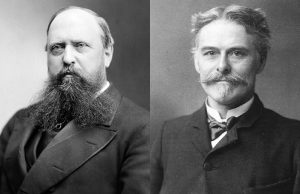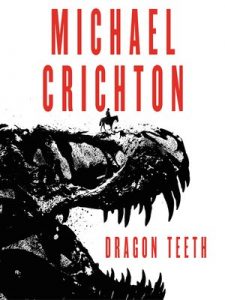
Othniel Charles Marsh (l) and Edward Drinker Cope
Also called the Great Dinosaur Rush, the Bone Wars comprises an interesting chapter in American history. The phrase refers to a period of fiercely competitive fossil hunting that took place during the latter part of the nineteenth century. Although many others got caught up in the obsessive hunt for dinosaur remains, its two primary antagonists were paleontologists Othniel Charles Marsh and Edward Drinker Cope. And wow, did these guys hate each other’s guts!
FROM COLLEAGUES TO RIVALS
As discoveries of fossils around the world hinted at the existence of the giants that once walked the Earth, the field of paleontology began to attract many scholars. Edwin Drinker Cope, a member of the Academy of Natural Sciences in Philadelphia, came from a wealthy Quaker family. Othniel Charles Marsh, on the other hand, came from a poor family in upstate New York. But Marsh had a benefactor: rich uncle George Peabody, a well-known philanthropist. Marsh would ultimately convince his uncle to fund the Peabody Museum of Natural History at (then-named) Yale College, with himself as its head. He also received a nice inheritance from Peabody in 1869, so both men were well funded for what was to come—at least at the start.
Cope’s Elasmosaurus, with the head on the wrong end.
Cope and Marsh met in 1864 and were colleagues for a time. At one point they even named newly discovered species after each other. But given their strong—some would say obnoxious—personalities, the friendship quickly deteriorated. Soon they were attacking each other in scientific journals, and when Cope’s reconstruction of a dinosaur called Elasmosaurus went awry—he had placed the head at the end of the tail—Marsh jumped all over it. By the 1870s they had become bitter enemies.
A TREASURE TROVE OF FOSSILS
Also in the 1870s, word came of huge fossil discoveries out west, specifically in Colorado, Montana, and other northern tier states. Both men led expeditions to the fossil fields, and despite underhanded methods by each—theft and destruction of bones, bribery of the other’s crew, spying, to name a few—the Bone Wars created a great interest in dinosaurs and ultimately led to the discovery of 136 new species by Marsh and Cope.

Marsh (back row, center) and his armed assistants.
So who “won” the Bone Wars? If you go by numbers, Marsh discovered eighty new species to Cope’s fifty-six. This likely had to do with Marsh having more funding, and also assistants, toward the end.
But that “end” came about in the 1890s, with both men socially and financially devastated by their nasty feud. Cope suffered from a gastrointestinal illness and passed away in 1897 at the age of fifty-six, having sold off part of his fossil collection just to get by. Marsh had to mortgage his house and ask Yale for a salary prior to his death two years later at age sixty-seven.
While Cope and Marsh added much to the science of paleontology—their discoveries included well-known species such as Stegosaurus, Triceratops, and Allosaurus—their descriptions of some species led to misconceptions in the field that lasted for many years. As someone once said, why can’t we all get along?
DRAGON TEETH
Over a decade before Jurassic Park the late, great Michael Crichton wrote a historical novel titled Dragon Teeth. For whatever reason, the book was not published until last year, and reading this posthumous gem made it even harder to accept the fact that Crichton passed away nearly ten years ago. Two of his main characters? Edward Drinker Cope and Othniel Charles Marsh. Yes, this is a story about the Bone Wars.
 Utilizing a fictional character named William Johnson, Crichton brings the bitter feud between Marsh and Cope to the forefront via simultaneous expeditions to the fossil fields, primarily in Montana. Johnson, a Yale student, wants to join Marsh’s team, but the paranoid Marsh, believing him to be one of Cope’s spies, tells him to get lost. Besides, he says, the only thing he really needs is a photographer. Johnson, who doesn’t know a thing about photography, takes a crash course and later joins the expedition.
Utilizing a fictional character named William Johnson, Crichton brings the bitter feud between Marsh and Cope to the forefront via simultaneous expeditions to the fossil fields, primarily in Montana. Johnson, a Yale student, wants to join Marsh’s team, but the paranoid Marsh, believing him to be one of Cope’s spies, tells him to get lost. Besides, he says, the only thing he really needs is a photographer. Johnson, who doesn’t know a thing about photography, takes a crash course and later joins the expedition.
Once they arrive out west, Marsh kicks Johnson off the team. He still believes the student is a spy. But someone else needs a photographer…yep, it’s Cope. So, through William Johnson, we have an intimate look at both paleontologists and experience the confrontations, the sabotage, and the ever-present paranoia that permeates both camps, not to mention the endless dangers from outlaws, Indians, and the challenging terrain that encompasses the fossil fields.
Other “characters” in the story include George Armstrong Custer, Wyatt Earp, Robert Louis Stevenson, and Brigham Young, to name a few. Dragon Teeth is the kind of storytelling that made Michael Crichton famous.
This post offers an abstract of the Bone Wars—the intense rivalry between two zealous paleontologists to discover dinosaur fossils. An excellent, detailed account can be viewed on the PBS show, American Experience: Dinosaur Wars (Season Four, Episode Two).

You had me at “dinosaur”. ;0)
Yeah, Indy, that’s about how I feel regarding the large lizards. 🙂
As a kid, I always felt more sympathetic towards Cope, being him the one with no money and the one who committed that tragic mistake that almost ruined his career.
Even now, I find it hard to like Marsh since he had all the money that ultimately helped him to find more dinosaur species than Cope. It’s a story about rich vs poor anyway. Belt driven by passion and love for dinosaurs, but fueled by the hatred they professed to each other.
This should totally be a movie.
As much as they accomplished, it is still a pretty sad story. Thanks for visiting my site. And I totally agree about the movie!